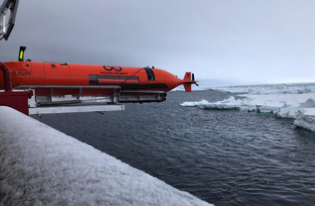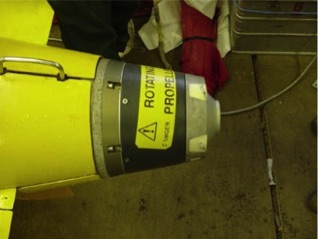What does Mission Planning encompass?
The planning phase is the activity that precedes the deployment of the AUV. In this phase, the manner in which the AUV will be operated is determined. Aspects that may be included are:
• The integration of new mission or payload sensors.
• The acquisition of spare parts for the vehicle or the payload.
• Logistic and mobilisation planning, including how the vehicle and its support equipment will get to the ice and into the water.
• Mission simulation.
• Issues related to insurance for personnel and the vehicle.
• Consideration of environmental issues, which may lead to the preparation of an Environmental Impact Assessment, which, if the impact is modest, may take the form of an Initial Environmental Evaluation.
All of these aspects need to be considered to some degree when planning any underwater vehicle mission. The principle differences with polar operations are that the areas of operation are generally very remote and that some form of ice cover is generally present. The remote nature of the operations makes communications with outside agencies sporadic. Re-supply is generally very costly and time consuming, and there may be periods where weather precludes any such operation.
This environment provides its own challenges to the AUV operator. Generally speaking, it is not a suitable environment for testing new equipment or concepts. Consequently, planning often involves the testing of such equipment and system integration in open water prior to a deployment. There may be instances in which the operator feels that it is too risky to carry a particular piece of equipment in the AUV during a polar operation.
Ice Conditions
The condition of the ice surface will be fundamentally important where Ice-Based missions are concerned. The thickness must be studied from a safety perspective as well as from the perspective of having to make a hole through which the AUV can be deployed. Other holes for remote communications and positioning may also be required, and as these are likely to be smaller, they will require some plan to ensure that they do not freeze over.
Ice cover also alters the environment in which the vehicle operates. Because of the ice cover and the absence of sea state and shipping, acoustic conditions may well be much better than in open water. However, the ice cover and a sound speed gradient may create more severe acoustic multi-paths, especially in shallow water. These factors need to be considered in planning missions and, if possible, acoustic data from prior missions in the area should be sought and examined. For sea-based operations, the mission will encounter the same conditions under-ice, however, in the marginal ice zone, conditions may be significantly worse. Environmental and weather data may not be as accurate or as frequent as it is in other parts of the world. Local knowledge may be an important source of information.
The conduct of operations in areas of ice cover also dictates that plans exist in the event that the vehicle is lost or becomes disabled. Such a plan may require the availability of specialised rescue equipment. In the event that the operator wishes to obtain insurance to cover loss of the AUV, the underwriter will look for evidence of a rescue plan. In addition, a fault-tolerant design and a well thought out fault management strategy may reduce the premium.
Best Practice for Planning AUV Missions Under-Ice
In many cases, environmental regulations are developed specifically for polar regions, and these should be fully understood prior to the commencement of operations. These regulations may include provisions for dealing with polar wildlife. If operating in the area covered by the Antarctic Treaty operators should familiarize themselves with the provisions of any national legislation implementing the provisions of the Antarctic Treaty. There may be a need for an Initial Environmental Impact Assessment. For an AUV, suitable headings under which to consider environmental impact would include:
• Noise, light and heat emissions.
• Equipment failure leading to loss; hazardous or polluting materials within the AUV.
• Creation of water turbulence affecting the environment.
• As a vector for the introduction of non-native species.
The remote aspects of most polar operations dictate that all of the equipment and spare parts needed to support the operation be acquired and taken to the site. New equipment integration and new procedures should be thoroughly tested in open water. Consider limiting the use of particularly risky equipment or procedures.
Planning should consider in detail the ice conditions and their probable impact on:
• The safety of an ice-based camp, if applicable,
• The ability and time required to make ice holes, and
• The likely acoustic conditions and their impact on the range of acoustic telemetry as well as sonar sensor coverage.
Future weather conditions may not be accurately predicted, and the best practice is to seek out local knowledge as a secondary source for planning polar operations.
Careful attention should be given to the design or design modification of the vehicle such that it is tolerant to sub-system failure and capable of managing faults. A fully thought out rescue plan is necessary.
AUV Mission Planning
The 2019 Weddell Sea Expedition completed a thorough Initial Environmental Evaluation for its operations, including the use of two Kongsberg Hugin AUVs. Illustration courtesy of the 2019 Weddell Sea Expedition.

How ice conditions may affect the risk of loss of an AUV can be assessed using a Bayesian Belief Network. Using a map such as that above, Brito et al. (2016) described the Bayesian method and the use of structured Expert Judgement to assess the baseline risk with a worked example for Autosub3 missions in the Amundsen Sea.


Despite the sea surface appearing to be completely clear of ice, there has been at least one occasion on which all five of the composite propeller blades on the Autosub AUV were broken during a dive that began with a run on the surface. If there is any possibility of surface ice, a drop-weight dive should be seriously considered. Image from Peter Stevenson.
